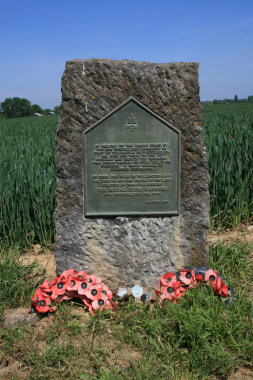
Inniskilling memorial at Waterloo
In last weeks post, I gave a brief description of La Haie Sainte Farm House and my observations from the battlefield visit to Waterloo. This week, I thought the I would take a look at a different part of the battle. When we were planning to visit Waterloo, it seemed appropriate that we would take some of our figures to the actual battlefield. I had been inspired by the stoic bravery of the 27th Regiment of Foot, the Inniskillings, during the battle and had painted one of my Battalions to represent them. It just seemed right to take them to the Battlefield.
The Inniskillings had been held in reserve during the battle until around 3.00pm when they were ordered up to defend the crossroads. Following the loss of La Haie Sainte, they were ordered to form square. This wasn’t so much a response to any imminent cavalry threat but such a formation would allow them to deliver fire to the side towards the Brussels road as well as to the front, over the ridge towards the french advance.
The densely packed ranks of such a formation made a tempting target for both the French Guns and the many French skirmishers – a target that they could hardly miss. As a result, the battalion, commanded by Captain John Hare, suffered terrible casualties, losing 66% of it’s men and officers. Of the Nineteen officers with the Battalion, sixteen were killed or wounded, leaving many of the Companies to be commanded by Sergeants. The memorial reads:

Inniskillings on memorial
In Memory of the heroic stand by the 27th (Inniskilling) Regiment of Foot at the Battle of Waterloo on 18th June 1815 when, of the 747 Officers and men of the regiment who joined the battle, 493 were killed or wounded. A noble record of endurance. Of them, the Duke of Wellington said, ‘Ah, they saved the centre of my line’. Erected by their successors, The Royal Irish Rangers (27th Inniskillings, 83rd,87th) 18 June 1990.
My act of remembrance was to take the regiment that I had painted to the battlefield – here they are on the memorial once again, facing out across Waterloo.
The models are Perry miniatures from the plastic box set. I have painted them with Buff facings and with buff cross straps. I am not sure if this is entirely correct. Some pictures show the troops with the standard white belts, others with buff. I have also painted the officer with buff trousers or coveralls. I suspect that this is incorrect as the Officers would have worn Grey trousers as was standard for campaign duty. However, I had seen a picture showing an Ensign in buff trousers and according to a reference in C.E. Franklins British Napoleonic Uniforms, the Officers wore Buff breeches – however, I think that this is the dress uniform rather than campaign. That all said, Officers were responsible for their own uniforms and given the haste with which the British Army moved out to Waterloo, may be this officer stayed in his dress uniform… Regardless, I just wanted the unit to look a bit different on the gaming table. Finally, here is a close up of the models actually on the Battlefield of Waterloo, roughly in the position that the real Troops would have made their Stand.

Inniskillings 2014
